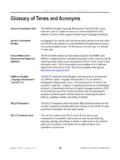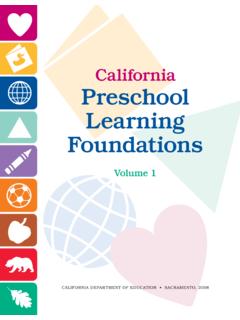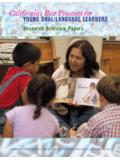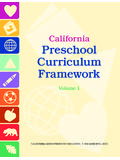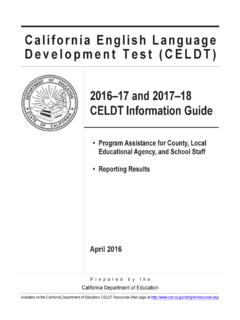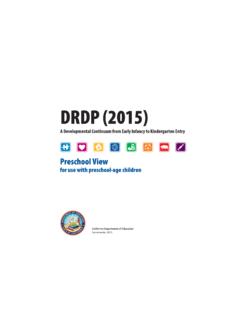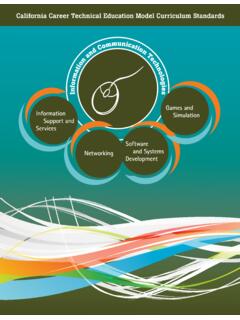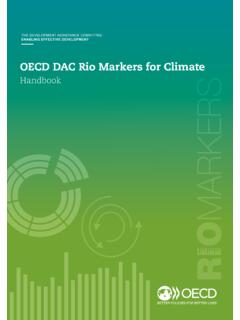Transcription of SOCIAL SCIENCE FRAMEWORK - California Department of …
1 CHAPTER SEVENH ISTORYSOCIAL SCIENCE F RAM EWOR KFOR California PUBLIC SCHOOLSK indergarten Through Grade TwelveAdopted by the California State Board of Education Ju ly 2016 Published by the California Department of Education Sacramento, 2017 Grade FourCHAPTER 7 California : A Changing State n Why did different groups of immigrants decide to move to California ? n What were their experiences like when they settled in California ? n How did the region become a state, and how did the state grow?The history of California is rich with ethnic, SOCIAL , and cultural diversity; economic energy; geographic variety; and growing civic community. The study of California history in the fourth grade provides students with foundational opportunities to learn in depth about their state, including the people who live here, and how to become engaged and responsible citizens.
2 California s history also provides students with the opportunity to develop important language and literacy skills and to learn that history is an exciting, investigative discipline. As students participate in investigations about the past, they will learn to identify primary sources, understand them as a product of their time and perspective, and put them in a comparative context. California History SOCIAL SCIENCE FRAMEWORK | Chapter 7 67 Grade FourStudents will also learn to make claims (through writing and speaking) about sources and how to use textual evidence to support a story of California begins in pre-Columbian times, in the cultures of the American Indians who lived here before the first Europeans arrived.
3 The history of California then becomes the story of successive waves of immigrants from the sixteenth century through modern times and the enduring marks each left on the character of the state. Throughout their study of California history, students grapple with questions to understand the impact of (im) migration to California . Why did different groups of immigrants decide to move to California ? What were their experiences like when they settled in California ? How were they treated when they arrived in California ? These immigrants include (1) the Spanish explorers, Indians from northern Mexico, Russians, and the Spanish Mexican settlers of the mission and rancho period, known as Californios, who introduced European plants, agriculture, and a herding economy to the region; (2) the Americans who settled in California , established it as a state, and developed mining, trade in animal hides, industries, and an agricultural economy.
4 (3) the Chinese, Japanese, Koreans, Filipinos, South Asians (predominantly Sikhs), and other immigrants of the second half of the nineteenth century and the early decades of the twentieth who provided a new supply of labor for California s railroads, agriculture, and industry and contributed as entrepreneurs and innovators, especially in agriculture; (4) the immigrants of the twentieth century, including new arrivals from Latin America and Europe; and (5) the many immigrants arriving today from Latin America, the nations of the Pacific Basin and Europe, and the continued migration of people from other parts of the United of their early arrival in the New World, primarily because of the slave trade, people of African descent have been present throughout much of California s history, contributing to the Spanish exploration of California , the Spanish Mexican settlement of the region, and California s subsequent development throughout the nineteenth and twentieth bring California s history, geography, diverse society, and economy to life for students and to promote respect and understanding.
5 Teachers emphasize its people in all their ethnic, racial, gender, and cultural diversity. fourth -grade students learn about the daily lives, adventures, accomplishments, cultural traditions, and dynamic energy of the residents who formed the state and shaped its varied 68 Chapter 7 | California History SOCIAL SCIENCE FrameworkGrade Fourlandscape. There are multiple opportunities for students to learn what citizenship means by exploring the people and structures that define their grade four, emphasis is also placed on the regional geography of California . Students analyze how regions of the state have developed through the interaction of physical characteristics, cultural forces, and economic activity and how the landscape of California has provided different resources to different people at different times, from the earliest era to the present.
6 Through an understanding of maps, geographic information, and quantitative analysis, students should come away from their California history course with an understanding of the important interactions between people and their , students will be able to develop chronological thinking by creating and utilizing timelines that document events and developments that changed the course of California history such as pre-Columbian settlements, European settlement, the mission period, the Mexican-American War, the Bear Flag Republic, the Gold Rush, California s admission to statehood in 1850, and the state s rapid growth in the twentieth century. Most importantly, as students delve into various topics and inquiries throughout the year, they should be encouraged to see the big picture and understand a broader historical context rather than simply understanding discrete events and people as isolated features of the can facilitate a broader contextual explanation of California s history by asking investigative and interpretive questions over the course of the year.
7 Questions may include When did California grow? This question can be explained in demographic, geographic, and economic terms. Students may also consider fundamental questions that help define and understand their home, such as Who lived in California ? Who led California ? and How did the region change when it became a state?Physical and Human Geographic Features That Define Californian nHow do climate and geography vary throughout the state? How do these features affect how people live?By the fourth grade, students geographic skills have advanced to the point where they can use maps to identify latitude and longitude, the poles and California History SOCIAL SCIENCE FRAMEWORK | Chapter 7 69 Chapter 7 | California History SOCIAL SCIENCE FrameworkGrade Fourhemispheres, and plot locations using coordinates.
8 Students locate California on the map and analyze its location on the western edge of North America, separated from the more densely settled parts of the American heartland by mountains and wide desert regions, and understand that California , like much of the West, is arid; fresh water is a scarce commodity. They learn to identify the mountain ranges, major coastal bays and natural harbors, and expansive river valleys and delta regions that are a part of the setting that has attracted settlement for tens of thousands of their study of California history, students will use maps, charts, and pictures to describe how California communities use the land and adapt to it in different ways.
9 As they examine California s physical landscape, students should be encouraged to ask and answer questions about the role of geographic features in shaping settlement patterns, agricultural development, urbanization, and lifestyle in the state. For example, students can investigate the relationship between climate and geography and day-to-day human activity with questions like these: How does the natural environment affect the type of house you build and how many neighbors you have? or How does the environment affect the type and quantity of food you eat?The study of geography is a natural place to integrate technology into the classroom. Students may use Google Earth to zoom in to view regions and landmarks or annotate a map of California with their ongoing notes about geographic features with an app such as who wish to design interdisciplinary or problem-based learning units may connect the study of geography to the Next generation SCIENCE Standards through an essential question: How do natural resources, climate, and landforms affect how plants, animals, and people live?
10 As students study the major regions of California , they might also explore how rainfall helps to shape the land and affects the types of living things found in a region. 70 California History SOCIAL SCIENCE FRAMEWORK | Chapter 7 Grade FourPre-Columbian Settlements and Peoplen nWhat was life like for native Californians before other settlers arrived?n nHow did the diverse geography and climate affect native people? California has long been home to American Indian peoples; there is archaeological evidence of indigenous populations extending back to at least 9,000 years BCE.

